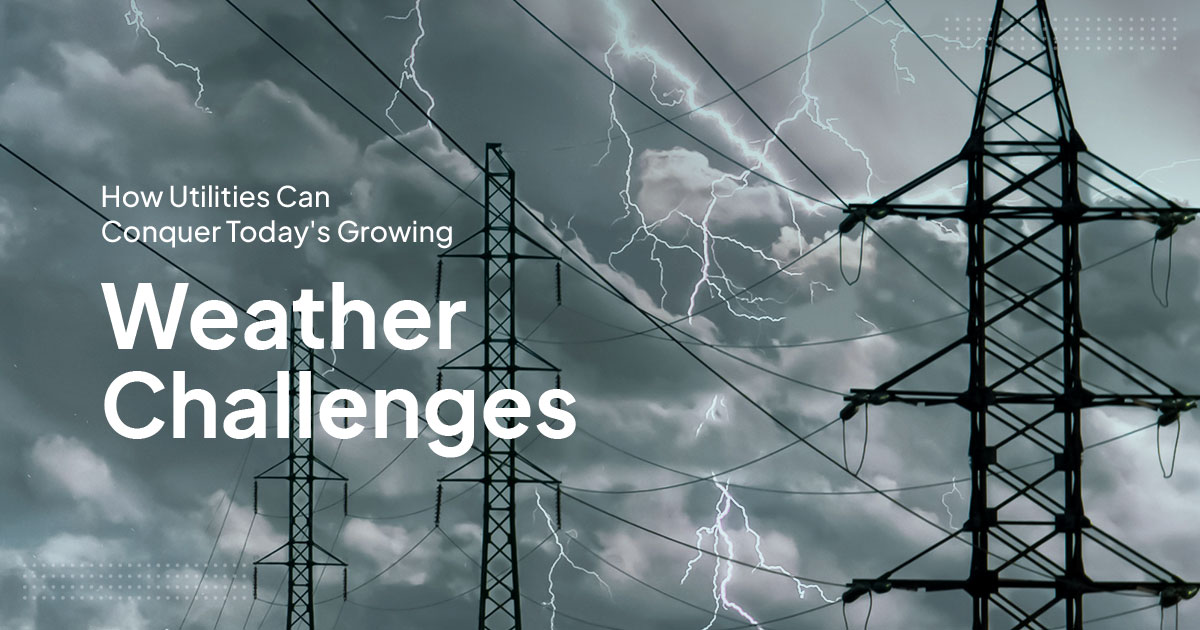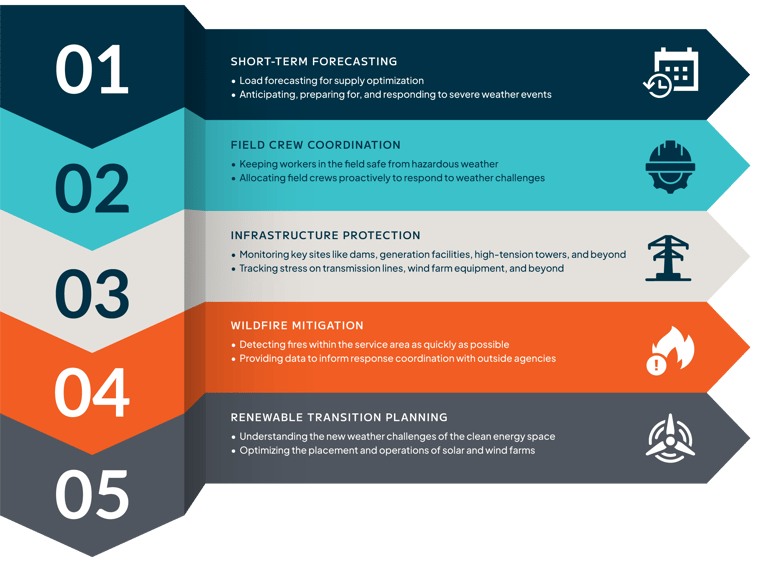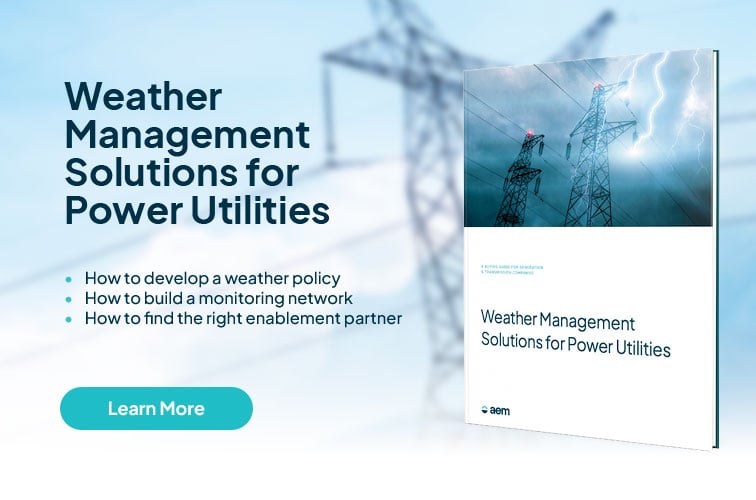
Whether it's low temperatures icing out the population of Texas or long-term drought leading to massive fires in California, it seems like the ongoing battle between energy utilities and the weather has been one of the main news stories of the last five years. In order to be successful in their mission of providing service continuity to customers while protecting the integrity of the grid, energy providers need to start thinking about weather challenges differently.
Moving forward, we'll explore...
- What weather challenges for utilities look like at ground level
- Which specific types of weather are creating challenges in the utilities space
- How utilities can overcome those weather challenges
How does the weather create challenges for utilities?
As long as there are power lines and generation equipment, the weather will present challenges to energy generation, transmission, and distribution. Generally speaking, those challenges can be broken down into five different categories:
Forecasting is a major challenge for energy utilities, as exact customer needs vary from day to day based on a number of factors, chiefly the weather. When demand is high due to extreme high or low temperatures, supply shortfalls can lead to providers needing to buy additional energy at peak prices, damaging profitability and often passing rising costs along to the customer. On the other hand, if a utility is generating more energy than the demand requires, that can quickly turn into waste and overspend as well.
Understanding the weather isn't just about knowing how much electricity to provide, however; it's about understanding how to manage operations from end to end. That means allocating work crews where they're needed most and keeping them out of danger when severe weather is creating havoc, tracking how weather is straining infrastructure to prioritize proactive maintenance, and so on.
Those challenges have always been baked into doing business in the world of energy, but some new obstacles to business have providers thinking about the weather even more. Major wildfires have emerged as a threat to the utility industry, both in terms of the health of the grid and when it comes to securing the insurance necessary to do business. Once-in-a-lifetime transitions toward renewables are also forcing energy providers to rethink their relationship to and way of looking at the weather.
What kinds of weather create challenges for utilities?
Too much of any kind of weather can have a potentially devastating effect on the grid. With that said, here are the four main types of weather that are challenging energy providers across the U.S. and world right now:
Heatwaves & drought
Heatwaves and drought are two of the most common types of extreme weather. Heatwaves cause demand for electricity to surge as people use air conditioning units to stay cool. Meanwhile, drought reduces water availability which in turn limits the ability of some hydroelectric power plants to generate electricity. Furthermore, prolonged dry spells increase the likelihood of wildfires, which can threaten both power plants and transmission/distribution lines.
Extreme low temperatures & ice
Cold temperatures also have an effect on energy utilities as people tend to use more electricity when it’s cold outside to keep their homes warm. This increase in usage leads to higher operating costs for utilities due to the additional fuel required to generate electricity. Additionally, snow and ice storms can lead to power outages due to downed trees and power lines which further increases operating costs by requiring additional staff hours in order to restore power as quickly as possible.
Severe storms & floods
Flooding or hurricanes can also pose serious challenges for energy utilities. Floodwaters have the potential to inundate power plants and underground electrical systems, causing significant damage or even complete failure of equipment in some cases. Likewise, hurricanes can devastate power lines while also damaging transmission towers and substations due to high winds and flying debris. Storm surges have been known to inundate coastal nuclear plants threatening their safety systems and operations as a whole.
High winds
When trees come into contact with power lines or other related infrastructure due to wind, it can cause massive outages and even fires. In the relatively new world of wind farming, strong winds from the wrong direction can impede operations, damage windmills, and put workers in extreme danger. That's why studying and understanding wind is now more important than ever when it comes to both planning and protecting grid infrastructure.
How can utilities overcome growing weather challenges?
Leverage the support of private forecasting services
The National Weather Service and state meteorological agencies simply don't have the resources necessary to provide forecasts and guidance that are tailored to each individual community that might be affected by a major weather event. Private and public entities, from governments to utilities, are increasingly using forecasting services to support their operations and employee safety. By working with a dedicated meteorology services team, you can get exactly the weather intelligence you need for your specific location, work, and challenges.
Build a local weather monitoring network
The best way to maximize the potential of your weather intelligence is to ensure your community or service area is richly mapped with weather and environmental monitoring sensors. A robust local sensor network will ensure you have total awareness of developing or potentially threatening conditions in your area, making it easier to provide guidance or warning to field service crews and. That information can be shared with other public safety and emergency management stakeholders to ensure a data-powered response that's designed to keep people safe while protecting infrastructure.
Plan thresholds that turn weather data into action
If you've got a weather monitoring network that tells you when severe weather is headed your way and a forecasting team that can help you interpret that data in the clearest possible manner, the only thing missing is action. That's where policies and threshold-based notifications come into play to mobilize that message. By building an automated and responsive alert/notification system around your weather intelligence, you can ensure that everybody -- employees, the public, and beyond -- gets the information they need to keep themselves and the community safe in a time of crisis.
Want to talk to a weather specialist who knows all about utilities?
If you're an in-house meteorologist or an operational safety leader at an energy utility, you're either feeling the pain of weather challenges right now or nervously awaiting Mother Nature throwing something crazy your way. Here's the good news, though: help is out there!
AEM's team of utility specialists can guide you through the process of understanding your weather challenges fully, identifying technologies that can close visibility gaps to create best-yet situational awareness, and enabling your team to foster weather-readiness and community resiliency at scale.
If you're ready, let's start a conversation today.


